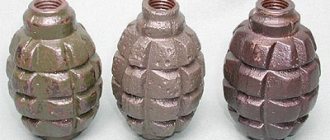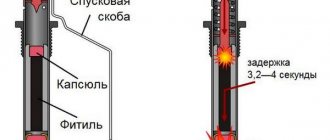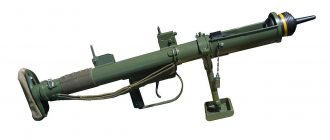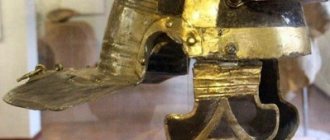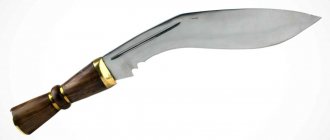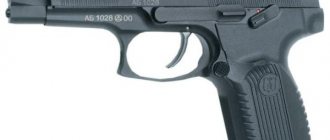Defense[edit | edit code]
The anti-cumulative shield appeared as a response to the creation of cumulative ammunition before World War II in Germany. During the war, Soviet tank crews welded special factory-made mesh screens (erroneously interpreted in the West as armored beds), thin sheets of iron and tin to the armor for protection against German man-portable anti-tank weapons with cumulative ammunition such as “Faustpatron”, “Panzerfaust”, etc. Anti-cumulative screens were not widely used at that time, since according to the results of Soviet tests in 1945 they showed themselves to be ineffective against the latest versions of faust cartridges (from typical distances of urban combat, armor was still penetrated, although the diameter of the hole decreased). The hulls of German Tiger tanks were coated with a special composition called Zimmerit to prevent magnetic mines from being attached to them. The same measures were taken in relation to the German Panther tanks and self-propelled guns of the last period of World War II. However, such mines were used only by the German army and were not used by its opponents, and at the same time, applying such a coating was troublesome and time-consuming, so in 1944, after a year of use, it was abandoned. Even during the Second World War, it was noticed that the damage to a tank is often less if the shell hitting the tank hits explosives mounted on top of the tank’s armor. At first, such observations were considered, although worthy of trust, to be practically inapplicable, since in a number of cases not only the anti-tank projectile suffered, but also the armor itself. However, the topic itself was not closed, and the first samples of dynamic protection were developed in the USSR in the late 1950s at the Steel Research Institute under the leadership of academician Bogdan Voitsekhovsky (Lenin Prize 1965); in the mid-60s, similar developments were carried out in Germany by research engineer Manfred Held
) - MBB-Schrobenhausen concern. For a number of reasons, such as the sufficient level of protection of the Soviet armored vehicles at the time of the creation of dynamic protection, its production did not begin until the mid-80s. For the first time, dynamic protection, created on the basis of German experience, was installed on Israeli tanks during the 1982 Lebanon War.
Training and simulation grenades[edit | edit code]
| External media files | |
| Split grenades |
Training and simulation grenades not only copied the shape and weight, but also simulated the explosion of grenades with sound and smoke effects using a small charge of black powder. Externally, they were distinguished by the presence of a hole in the bottom of the hull, through which powder gases escaped when simulating an explosion. Unlike split and training grenades, which were called the same as their combat prototypes, only with the addition of the word “cut” or “training”, training and imitation grenades had different names: the simulating RGK-3 was called UPG -8
(training anti-tank grenade). The imitation fuse consists of a striking mechanism and an imitation part, between which an adapter sleeve is placed. The striking mechanism is designed in the same way as that of the UZRGM fuse, only its firing pin is slightly longer. The imitation part also consists of the same parts as the UZRGM, but instead of a detonator capsule, it has a special cartridge case with a black powder charge. When reusing a grenade, only the firing pin and the imitation part of the fuse are changed. The remaining parts of the fuse and the grenade body are reused many times. Training and simulation grenades allow you to practice throwing skills.
Varieties of pomegranate
- pyropes - red and dark red garnets, the color is very thick, making the stones appear almost black
- rhodolites – pink, red-pink, violet-pink garnets, bright to neon color, are a mixture of pyropes and almandines
- almandines - deep red, violet-red, violet, crimson, brown-red garnets, rated lower than other varieties of garnets
- uvarovites - emerald green or grassy green garnets, large stones are very rare
- grossulars - light green, greenish-brown, yellowish garnets, are divided into several types: hessonites - brown, orange, yellow grossulars
- rosolites – pale pink, pinkish-red grossulars
- rumyantsevites – brownish-red grossulars
- succinites – amber-yellow grossulars
- tsavorites - green grossulars, the most valuable variety of grossulars
- hydrogrossulars - pale colored grossulars
- demantoids - green andradites, have a strong shine, the most valuable among all types of garnets
Garnet deposits
The most valuable dark almandines are now mined mainly on the Kola Peninsula, in Karelia, in the Fort Wrangel deposit (USA). They are found in small numbers in Ukraine, Brazil and Madagascar. In Azerbaijan, Primorye and Chukotka, beautiful intergrowths of andradites and hessonites are found. There are deposits of emerald green uvarovite in the Urals, Canada and Finland. Pyropes are mined on all continents (except Antarctica), but their deposits are few in number. Only transparent pyrope crystals are of jewelry value.
Magic properties
Garnet is generally considered a stone of love and passion among many peoples. Therefore, lovers often gave their beloved jewelry with garnets, and young unmarried girls wore jewelry with this particular stone... It is believed that the stone kindles passion and excites sexuality. But the pomegranate is also considered a symbol of power, courage, loyalty, strength, will and joy. In medieval Europe, it was believed that pomegranate would protect against wounds and poisons. But this gemstone can inflame not only passion, but also anger, so you should be careful with this stone. And black garnets will help you look into the future and communicate with the departed.
Liquid incendiary grenades[edit | edit code]
The usual design is a glass bottle containing a flammable liquid and an igniter (in the most primitive version, a rag soaked in flammable material is attached to the neck). When used, the fuse is ignited and the bottle is thrown at the target, the glass breaks, the flammable liquid spreads and ignites from the fuse. Typically contains alcohol and gasoline, but other flammable liquids have been used. To create smoke, tar or coal tar was added.
When it hits a target, the glass bottle breaks, the flammable mixture spills over the surface of the target and is ignited by the burning cap. Molotov cocktails are used primarily against vehicles and armored vehicles. When thrown, the main goal is to get the burning liquid into the engine compartment. Use involves a risk to life due to the need to get within throwing distance of the target. In general, the effectiveness of bottle attacks against armored vehicles is low - to hit the engine you need to get into the ventilation grilles behind the turret, and to do this you need to be on the side or behind the tank, which is usually only possible in urban guerrilla conditions, or by throwing a bottle from a trench, which moment the tank crosses. During World War II, tank ventilation grilles began to be covered with chain-link. Thanks to this, the bottles were springy and rolled off the tank without breaking. Modern tanks are equipped with reliable means of protection against flammable bottles, although fire damage to the external parts of the tank can lead to a decrease in its combat effectiveness. For the British Northover Projector ampulo launcher, a Molotov cocktail was standard ammunition.
British Northover Projector Molotov cocktail
Common myths about the hand grenade[ | ]
| This section is missing references to information sources. Information must be verifiable, otherwise it may be questioned and deleted. You may edit this article to include links to authoritative sources. This mark was set on August 3, 2020 . |
- A hand grenade explodes so powerfully that it destroys small buildings and scatters people to the sides
. In movies, such effects are created using pyrotechnics. In reality, a fragmentation hand grenade (unlike an anti-tank grenade) is not capable of causing significant destruction. Exploding a grenade, even in close proximity to a person, does not always kill him. - The hand grenade explodes with a deafening noise, sending up a ball of fire
. In movies, such effects are created using gasoline. In reality, the grenade explodes with a sharp bang, raising a small cloud of dust. - The grenade pin can be pulled out by the ring (and thereby put into combat mode) with your teeth
. In reality, such an attempt is more likely to lead to loss of teeth than checks. Without straightening the antennae, it is almost impossible to pull out the pin even by hand. After straightening the antennae, the pin is pulled out with a slight movement (training grenades, on the contrary, have a “heavy” pin, since they are used repeatedly, unlike combat grenades). To avoid accidental activation, the grenade cannot be activated even by a strong tug on the pin. - The radius of destruction of the grenade is 200 meters and this means that when it explodes, the fragments kill all living things in this radius
.
In this case, the radius of destruction
with
the radius of scattering of fragments
. For example, the F-1 defensive grenade has a damage radius of 20 meters; scattering of fragments - 200 meters. This means that within a radius of 20 meters, unprotected people are highly likely to be struck (killed or injured), and at a distance of over 200 meters - a safe distance at which unprotected people can be without any particular risk to health. The radius of complete destruction (the distance at which the probability of remaining alive is really extremely small) at the height of human growth for hand grenades usually does not exceed 5 meters [8]. Moreover, due to the peculiarities of the rupture of the metal parts of the grenade into damaging fragments and the loss of their speed, the damage caused decreases exponentially with increasing distance. - A modern grenade can be activated silently
. In all modern fuses, when the firing pin hits the primer, a noise comparable to a pistol shot is produced. Some early models of fuses fired with little noise, but these were abandoned due to unreliable operation or danger to the thrower.

